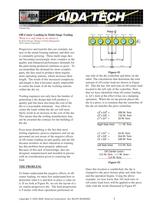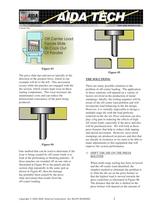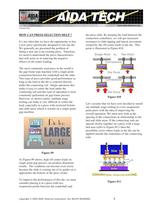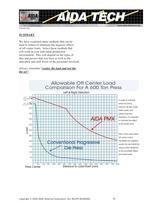
Excertos do catálogo

Volume One Off-Center Loading in Multi-Stage Tooling What it is and what to do about it. By Dennis Boerger, Manager of Product Management: AIDA-America Corporation Progressive and transfer dies are certainly not new to the metal forming industry and their use is constantly growing. These multi stage dies are becoming increasingly more complex as the quality and enhanced performance demands for the parts being produced continues to grow. To accommodate the demand for more complex parts, the dies used to produce them require more operating stations, which increases their length. The result of this increased complexity and length is that it becomes nearly impossible to center the loads of all the working stations within the die set. Tooling engineers not only have the burden of generating a die design that will produce a quality part but must also keep the cost of the die to a reasonable minimum. Any effort to center the loads within the die set will most likely result in an increase in the cost of the die. This means that the tooling manufacturer may not be awarded the contract for the building of the die. Figure #1 one side of the die centerline and three on the other. The calculations that determine the total amount of off-center load are shown in Figure #2. This die has 164 inch tons of off-center load located to the left side of the centerline. Now that we have identified what off-center loading is, let’s look at the effect it has on a stamping operation. When the set-up person places the die in a press, it is common that the centerline of the die set matches the press centerline. Even more disturbing is the fact that most tooling engineers, process engineers and set-up personnel are not aware of the negative effects of off-center loading on part quality and die life because nowhere in their education or training has this problem been properly addressed. Because of this lack of knowledge, dies are designed, manufactured and installed in presses with no consideration given to centering the load. THE PROBLEM: To better understand the negative effects of offcenter loading, we must first understand how to determine what it is and how to place a value on it. If we look at Figure #1, we see the layout of a six station progressive die. The feed progression is 8 inches with three operations performed on Figure #2 Once this location is established, the die is clamped to the press bolster plate and slide face and the operation begins. Using the above example, we now know that 164 inch-tons of off-center load force will be applied to the press slide with the result illustrated in Figure #3. Copyright © 2000 AIDA-America Corporation. ALL RIGHTS RESERVED. 1
Abrir o catálogo na página 1
Volume One Figure #3 Figure #5 The press slide tips and moves laterally in the direction of the greatest force, which in our example will be to the left. This movement occurs while the punches are engaged with the die section, which creates high wear on these mating components. This wear increases die maintenance costs and can reduce the dimensional consistency of the parts being produced. Figure #4 One method that can be used to determine if die wear is being created by off-center loads is to look at the perforating or blanking punches. If these punches are rounded off on one side as...
Abrir o catálogo na página 2
Volume One Figure #7 Figure #6 off-center load. Electronic tonnage monitors allow for very accurate positioning of the die to balance the load. The die is simply moved until the load readouts for the right and left sides of the press are matched. If the press is not equipped with tonnage monitors (as all presses should be), then we must rely on our calculations to properly locate the die. Remember to always center the load in the press and not the die set. 2) INTRODUCE A FALSE LOAD Shifting the die on the bolster is a very simple solution for load balancing. However, not all presses have...
Abrir o catálogo na página 3
Volume One HOW CAN PRESS SELECTION HELP ? It’s not often that we have the opportunity to buy a new press specifically designed to run one die. We generally are presented the problem of fitting a new die to an existing press. Therefore, we need to understand the press characteristics that will assist us in reducing the negative effects of off-center loading. The most commonly used press in the world is the gap frame type machine with a single point connection between the crankshaft and the slide. This type of press provides good performance as long as the load in the die is centered directly...
Abrir o catálogo na página 4
Volume One This occurrence will result in excessive slide tipping and lateral movement and will provide unsatisfactory results. to give the values for total bearing and slide guide clearance. These values must be checked Selecting a press that has wide spaced connecting rods (refer to Figure #12), will result in superior performance. Figure #14 and maintained on a regular basis or press and system performance will suffer. Figure #12 Another area of the press structure that has a direct relationship to is the overall bearing clearance and the clearance in the slide guide system. Figure #13...
Abrir o catálogo na página 5
Volume One SUMMARY We have examined many methods that can be used to reduce or eliminate the negative effects of off-center loads. Select those methods that will work in your individual production environment. This will depend on the types of dies and presses that you have as well as the education and skill levels of the personnel involved. Always remember “center the load and not the die set”. Copyright © 2000 AIDA-America Corporation. ALL RIGHTS RESERVED. 6
Abrir o catálogo na página 6Todos os catálogos e folhetos técnicos Aida S.r.l.
-
dsf-c1-n1-n2-specs
6 Páginas
-
NC Specs
2 Páginas
-
DSF-C1-A
1 Páginas
-
CHI
2 Páginas
-
Transfer Systems/Transfer Presses
2 Páginas
-
AIDA - Blanking line
9 Páginas
-
Total transfer knowledge
3 Páginas
-
Transfer press
2 Páginas
-
Servo Mechanical Presses
1 Páginas
Catálogos arquivados
-
Reverse tonnage
8 Páginas
-
Slide guide systems
4 Páginas
-
Transfer Technology Systems
4 Páginas
-
Slide Suspension Designs
4 Páginas
-
Press Balancing Systems
3 Páginas
-
Link Motion in Mechanical Presses
6 Páginas
-
Hydraulic Overload Protection - HOLP
7 Páginas
-
AIDA - Manufacturing locations
2 Páginas
-
NC2 Gap Frame Presses
4 Páginas
-
NC1 Gap Frame Presses
6 Páginas
-
HMX-M High Speed Lamination Presses
6 Páginas
-
AIDA Srl COMPANY PROFILE
8 Páginas
-
AIDA PRODUCT BROCHURE
6 Páginas


























